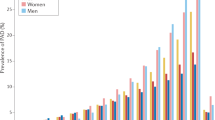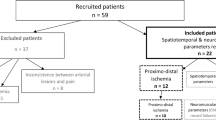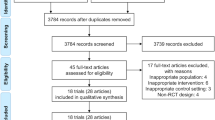Abstract
Claudication resulting from peripheral arterial disease causes substantial impairment in the ability to carry out normal daily activities. The medical treatments for claudication that are currently available are exercise rehabilitation and one drug, cilostazol. Pentoxifylline, which improves red cell deformability, lowers fibrinogen levels and decreases platelet aggregation, has been used historically, but frequency of use has declined because of limited effectiveness. Exercise rehabilitation, while efficacious, has been underused in the past. This therapy is, however, currently the subject of several large research projects. These studies are investigating mechanisms by which exercise therapy could benefit people with claudication and are also directly comparing it with other therapies. Concurrently, several new drug therapies for claudication are in the process of being evaluated. These research efforts might increase the available armamentarium and thereby help to alleviate the impairments associated with this symptom. The aim of this article is to discuss the current medical treatments being developed for use in patients with claudication resulting from peripheral arterial disease.
Key Points
-
Peripheral arterial disease is a common form of atherosclerotic disease
-
Claudication is a disabling symptom of peripheral arterial disease, but few medical treatments are available to treat the condition
-
Numerous agents are currently under evaluation as claudication therapies
-
Exercise training is an efficacious therapy for claudication but is underused in the clinical setting
This is a preview of subscription content, access via your institution
Access options
Subscribe to this journal
Receive 12 print issues and online access
$209.00 per year
only $17.42 per issue
Buy this article
- Purchase on Springer Link
- Instant access to full article PDF
Prices may be subject to local taxes which are calculated during checkout
Similar content being viewed by others
References
Criqui MH et al. (1985) The prevalence of peripheral arterial disease in a defined population. Circulation 71: 510–515
Hiatt WR et al. (1995) Effect of diagnostic criteria on the prevalence of peripheral arterial disease. The San Luis Valley diabetes study. Circulation 91: 1472–1479
Criqui MH et al. (1997) The epidemiology of peripheral arterial disease: importance of identifying the population at risk. Vasc Med 2: 221–226
Centers for Disease Control and Prevention (2005) Lower extremity disease among persons aged ≥40 years with and without diabetes—United States, 1999–2002. MMWR Morb Mortal Wkly Rep 54: 1158–1160
Hiatt WR (2005) The US experience with cilostazol in treating intermittent claudication. Atheroscler Suppl 6: 21–31
Regensteiner JG and Hiatt WR (2002) Current medical therapies for patients with peripheral arterial disease: a critical review. Am J Med 112: 49–57
Hirsch AT et al. (2006) ACC/AHA 2005 guidelines for the management of patients with peripheral arterial disease (lower extremity, renal, mesenteric, and abdominal aortic): executive summary a collaborative report from the American Association for Vascular Surgery/Society for Vascular Surgery, Society for Cardiovascular Angiography and Interventions, Society for Vascular Medicine and Biology, Society of Interventional Radiology, and the ACC/AHA Task Force on Practice Guidelines (Writing Committee to Develop Guidelines for the Management of Patients With Peripheral Arterial Disease) endorsed by the American Association of Cardiovascular and Pulmonary Rehabilitation; National Heart, Lung, and Blood Institute; Society for Vascular Nursing; TransAtlantic Inter-Society Consensus; and Vascular Disease Foundation. J Am Coll Cardiol 47: 1239–1312
Hirsch AT et al. (2001) Peripheral arterial disease detection, awareness, and treatment in primary care. JAMA 286: 1317–1324
Criqui MH et al. (1996) The correlation between symptoms and non-invasive test results in patients referred for peripheral arterial disease testing. Vasc Med 1: 65–71
Hiatt WR et al. (1990) Benefit of exercise conditioning for patients with peripheral arterial disease. Circulation 81: 602–609
Carter SA (1969) Clinical measurement of systolic pressures in limbs with arterial occlusive disease. JAMA 207: 1869–1874
Hiatt WR et al. (1988) The evaluation of exercise performance in patients with peripheral vascular disease. J Cardiopulm Rehabil 12: 525–532
Labs KH et al. (1999) Reliability of treadmill testing in peripheral arterial disease: a comparison of a constant load with a graded load treadmill protocol. Vasc Med 4: 239–246
Regensteiner JG et al. (1996) Exercise training improves functional status in patients with peripheral arterial disease. J Vasc Surg 23: 104–115
Regensteiner JG et al. (2002) Effect of cilostazol on community-based walking ability and health-related quality of life in patients with peripheral arterial disease: results of six randomized controlled trials. J Am Geriatr Soc 50: 1939–1946
McDermott MM et al. (1998) Measurement of walking endurance and walking velocity with questionnaire: validation of the walking impairment questionnaire in men and women with peripheral arterial disease. J Vasc Surg 28: 1072–1081
Regensteiner JG et al. (1993) Functional benefits of peripheral vascular bypass surgery for patients with intermittent claudication. Angiology 44: 1–10
Porter JM et al. (1982) Pentoxifylline efficacy in the treatment of intermittent claudication: multicenter controlled double-blind trial with objective assessment of chronic occlusive arterial disease patients. Am Heart J 104: 66–72
Dawson DL et al. (2000) A comparison of cilostazol and pentoxifylline for treating intermittent claudication. Am J Med 109: 523–530
Packer M et al. (1991) Effect of oral milrinone on mortality in severe chronic heart failure, The PROMISE Study Research Group. N Engl J Med 325: 1468–1475
The Scandinavian Simvastatin Survival Study group (1994) Randomised trial of cholesterol lowering in 4444 patients with coronary heart disease: the Scandinavian Simvastatin Survival Study (4S). Lancet 344: 1383–1389
Mohler ER III et al. (2003) Cholesterol reduction with atorvastatin improves walking distance in patients with peripheral arterial disease. Circulation 108: 1481–1486
McDermott MM et al. (2003) Statin use and leg functioning in patients with and without lower-extremity peripheral arterial disease. Circulation 107: 757–761
Mondillo S et al. (2003) Effects of simvastatin on walking performance and symptoms of intermittent claudication in hypercholesterolemic patients with peripheral vascular disease. Am J Med 114: 359–364
Brevetti G et al. (1995) Propionyl-9 pt-carnitine in intermittent claudication: double-blind, placebo-controlled, dose titration, multicenter study. J Am Coll Cardiol 26: 1411–1416
Hiatt WR et al. (2001) Propionyl-l-carnitine improves exercise performance and functional status in patients with claudication. Am J Med 110: 616–622
Brevetti G et al. (1999) European multicenter study on propionyl-L-carnitine in intermittent claudication. J Am Coll Cardiol 34: 1618–1624
Khan TA et al. (2003) Gene therapy progress and prospects: therapeutic angiogenesis for limb and myocardial ischemia. Gene Ther 10: 285–291
Lederman RJ et al. (2002) Therapeutic angiogenesis with recombinant fibroblast growth factor-2 for intermittent claudication (the TRAFFIC study): a randomised trial. Lancet 359: 2053–2058
Rajagopalan S et al. (2003) Regional angiogenesis with vascular endothelial growth factor in peripheral arterial disease: a phase II randomized, double-blind, controlled study of adenoviral delivery of vascular endothelial growth factor 121 in patients with disabling intermittent claudication. Circulation 108: 1933–1938
Ahimastos AA et al. (2006) Brief communication: ramipril markedly improves walking ability in patients with peripheral arterial disease: a randomized trial. Ann Intern Med 144: 660–664
Horsch S and Walther C (2004) Ginkgo biloba special extract EGb 761 in the treatment of peripheral arterial occlusive disease (PAOD)—a review based on randomized, controlled studies. Int J Clin Pharmacol Ther 42: 63–72
Gardner AW and Poehlman ET (1995) Exercise rehabilitation programs for the treatment of claudication pain. A meta-analysis. JAMA 274: 975–980
Regensteiner JG (1997) Exercise in the treatment of claudication: assessment and treatment of functional impairment. Vasc Med 2: 238–242
Robeer GG et al. (1998) Exercise therapy for intermittent claudication: a review of the quality of randomised clinical trials and evaluation of predictive factors. Eur J Vasc Endovasc Surg 15: 36–43
Leng GC et al. (2000) Exercise for intermittent claudication. The Cochrane Database of Systematic Reviews, Issue 1, Art. No CD000990
Tsai JC et al. (2002) The effects of exercise training on walking function and perception of health status in elderly patients with peripheral arterial occlusive disease. J Intern Med 252: 448–455
Stewart KJ et al. (2002) Exercise training for claudication. N Engl J Med 347: 1941–1951
Gardner AW et al. (2002) Effects of long-term exercise rehabilitation on claudication distances in patients with peripheral arterial disease: a randomized controlled trial. J Cardiopulm Rehabil 22: 192–198
Alpert JS et al. (1969) Exercise and intermittent claudication. Blood flow in the calf muscle during walking studied by the xenon-133 clearance method. Circulation 39: 353–359
Clifford PC et al. (1980) Intermittent claudication: is a supervised exercise class worth while? Br Med J 280: 1503–1505
Gardner AW et al. (2000) Improved functional outcomes following exercise rehabilitation in patients with intermittent claudication. J Gerontol A Biol Sci Med Sci 55: M570–M577
Gibellini R et al. (2000) Exercise training in intermittent claudication. Int Angiol 19: 8–13
Wolosker N et al. (2003) Evaluation of walking capacity over time in 500 patients with intermittent claudication who underwent clinical treatment. Arch Intern Med 163: 2296–2300
Izquierdo-Porrera AM et al. (2000) Effects of exercise rehabilitation on cardiovascular risk factors in older patients with peripheral arterial occlusive disease. J Vasc Surg 31: 670–677
Author information
Authors and Affiliations
Corresponding author
Ethics declarations
Competing interests
Judith G Regensteiner is on the Speaker Bureau of Sanofi-Aventis. She currently receives funding for research into the mechanisms by which exercise training improves claudication as well as a comparison of exercise training and angioplasty from the National Institutes of Health. She is participating in a clinical trial of statins to treat claudication supported by KOS pharmaceuticals.
KJ Stewart has received funding from the NIH.
Rights and permissions
About this article
Cite this article
Regensteiner, J., Stewart, K. Established and evolving medical therapies for claudication in patients with peripheral arterial disease. Nat Rev Cardiol 3, 604–610 (2006). https://doi.org/10.1038/ncpcardio0660
Received:
Accepted:
Issue Date:
DOI: https://doi.org/10.1038/ncpcardio0660
This article is cited by
-
Triple versus dual antiplatelet therapy after percutaneous coronary intervention for coronary bifurcation lesions: results from the COBIS (COronary BIfurcation Stent) II Registry
Heart and Vessels (2015)
-
Exercise Therapy for Claudication: Latest Advances
Current Treatment Options in Cardiovascular Medicine (2013)



